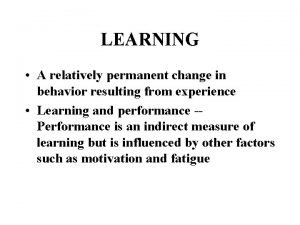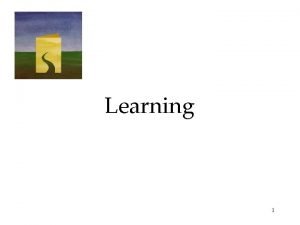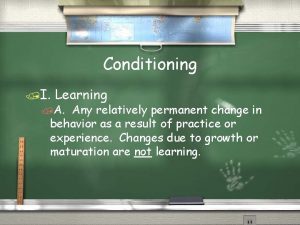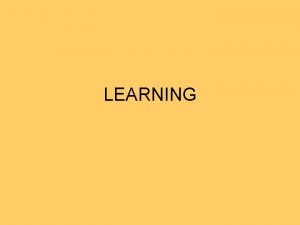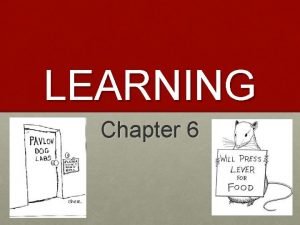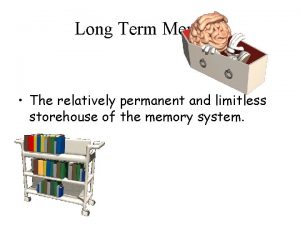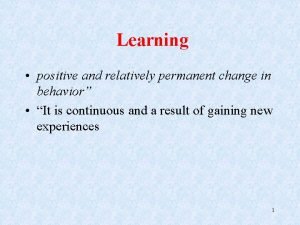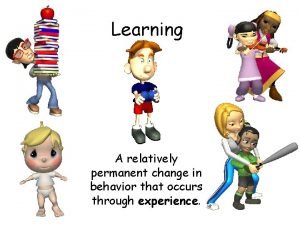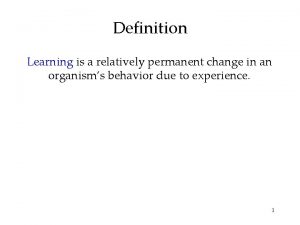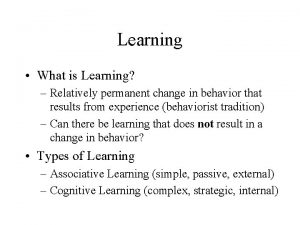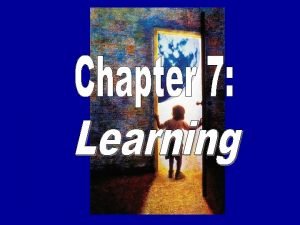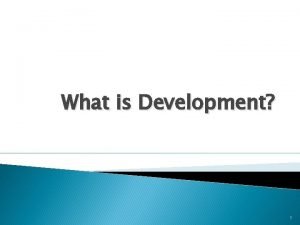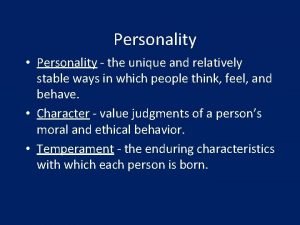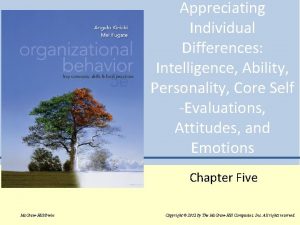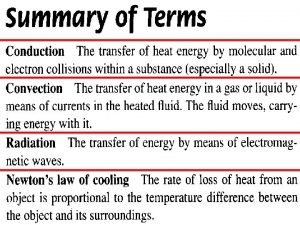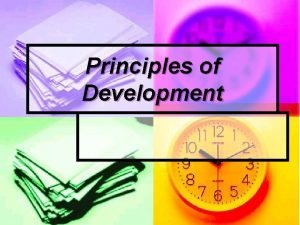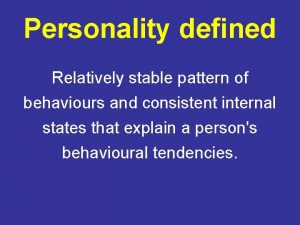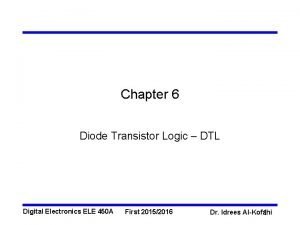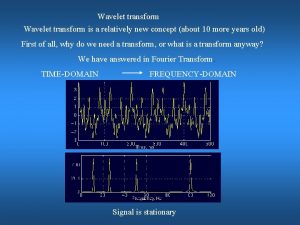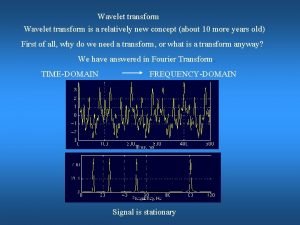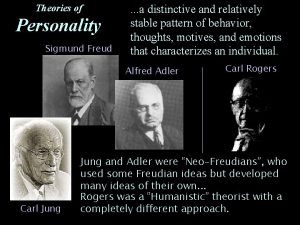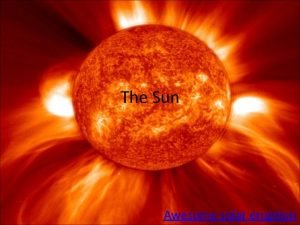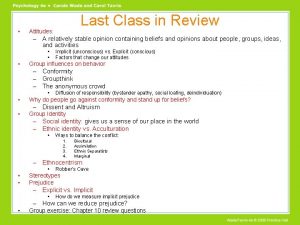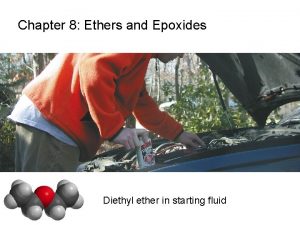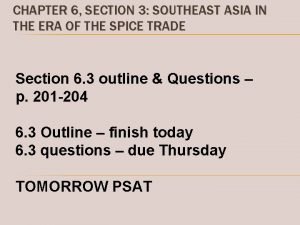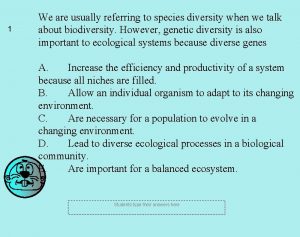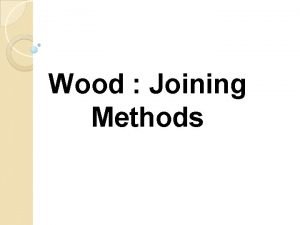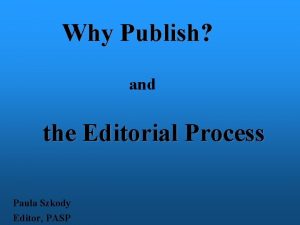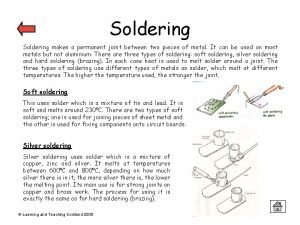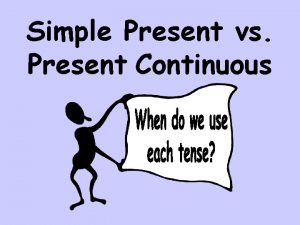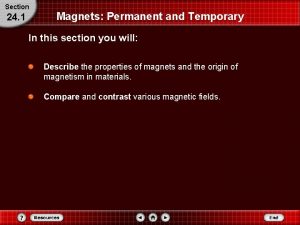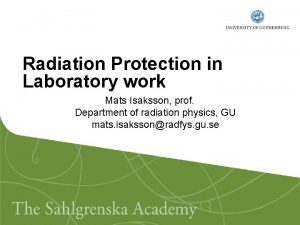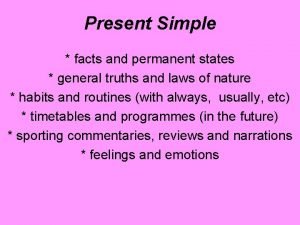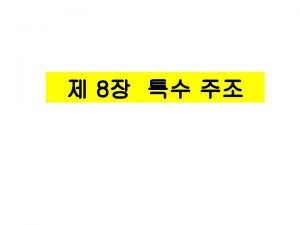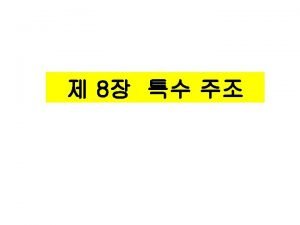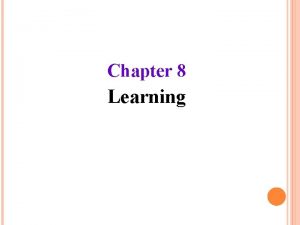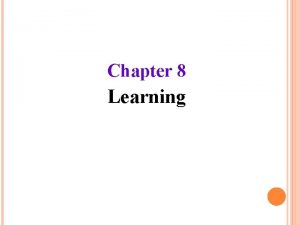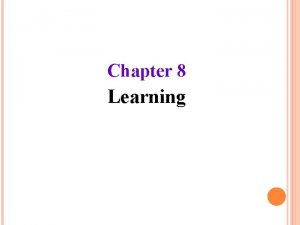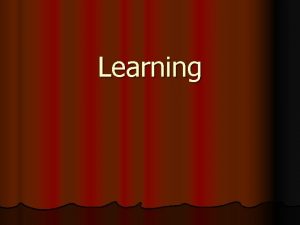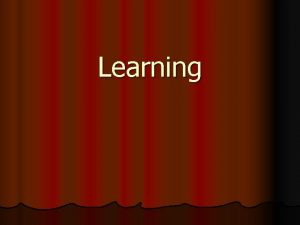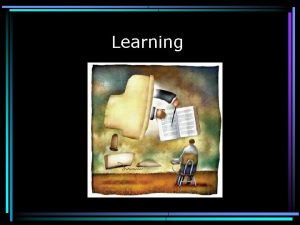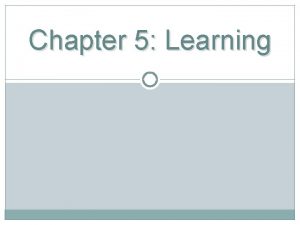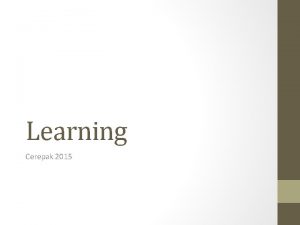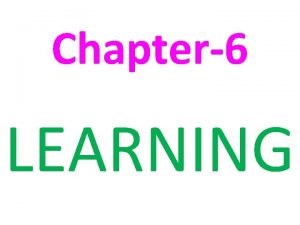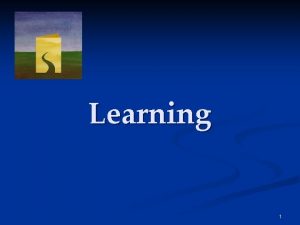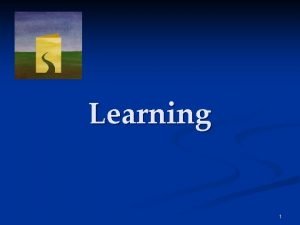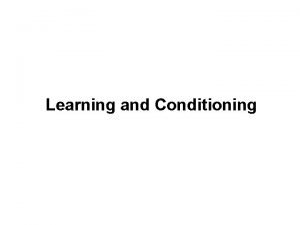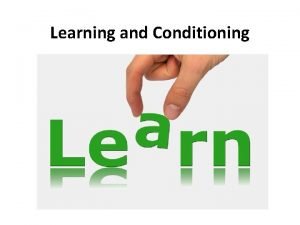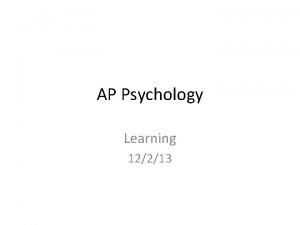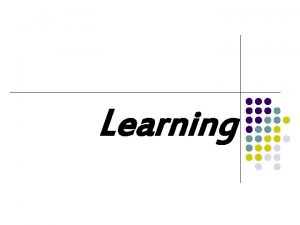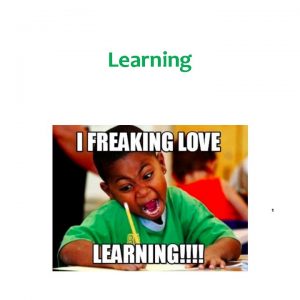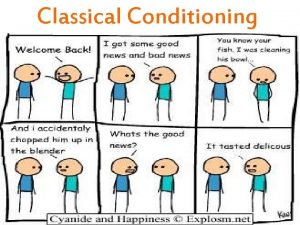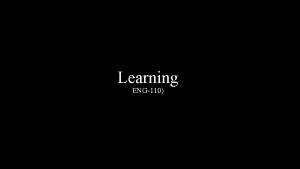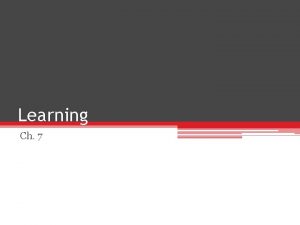Learning Chapter 8 1 Learning a relatively permanent













































- Slides: 45

Learning Chapter 8 1

Learning: a relatively permanent change in an organism’s behavior due to experience. - NURTURE in the Nature vs. Nurture debate Types of Learning: 1. Associative Learning - Classical Conditioning & Operant Conditioning - Our minds naturally connect events that occur in sequence. 2. Observational Learning - Watching others; modeled behavior 2

Classical Conditioning Stimulus-Stimulus Learning to associate one stimulus with another. 3

Classical Conditioning Pavlov’s Dogs Ivan Pavlov: Russian physiologist who pioneered study of classical conditioning. Sovfoto - provided a basis for later behaviorists like John Watson and B. F. Skinner. Ivan Pavlov (1849 -1936) 4

Elements of Classical Conditioning • Switch for notes 5

Pavlov’s Experiments Before conditioning, food (Unconditioned Stimulus, US) produces salivation (Unconditioned Response, UR). However, the tone (neutral stimulus) does not. 6

Pavlov’s Experiments During conditioning, the neutral stimulus (tone) and the US (food) are paired, resulting in salivation (UR). After conditioning, the neutral stimulus (now Conditioned Stimulus, CS) elicits salivation (now Conditioned Response, CR) 7

Acquisition is the initial stage in classical conditioning in which an association between a neutral stimulus and an unconditioned stimulus takes place. 1. In most cases: the neutral stimulus before the unconditioned stimulus. 2. The time in between the two stimuli should be about half a second. 8

Acquisition The CS needs to come half a second before the US for acquisition to occur. 9

Extinction When the US (food) does not follow the CS (tone), CR (salivation) begins to decrease and eventually causes extinction. 10

Spontaneous Recovery After a rest period, an extinguished CR (salivation) spontaneously recovers, but if the CS (tone) persists alone, the CR becomes extinct again. 11

Stimulus Generalization • Tendency to respond to stimuli similar to the CS • Pavlov conditioned the dog’s salivation (CR) by using miniature vibrators (CS) on the thigh. • Thus, the dogs generalized when responding 12

Stimulus Discrimination is the learned ability to distinguish between a conditioned stimulus and other stimuli that do not signal an unconditioned stimulus. 13

Applications of Classical Conditioning Brown Brothers Watson used classical conditioning procedures to develop advertising campaigns for a number of organizations, including Maxwell House, making the “coffee break” an American custom. John B. Watson 14

Extending Pavlov’s Understanding Pavlov and Watson underestimated the importance of cognitive processes and biological predispositions. 15

Biological Predispositions Even humans can develop classically to conditioned nausea. 16

Applications of Classical Conditioning 1. Alcoholics may be conditioned (aversively) by reversing their positiveassociations with alcohol. 2. Through classical conditioning, a drug (plus its taste) that affects the immune response may cause the taste of the drug to invoke the immune response. 17

Operant Conditioning Response-Consequence Learning to associate a response with a consequence (reward or punishment) 18

Operant Conditioning Response-Consequence Learning to associate a response with a consequence (reward or punishment) 19

B. F. Skinner’s Experiments Skinner’s experiments extend Thorndike’s thinking, especially his law of effect. This law states that rewarded behavior is likely to occur again. Yale University Library 20

Walter Dawn/ Photo Researchers, Inc. From The Essentials of Conditioning and Learning, 3 rd Edition by Michael P. Domjan, 2005. Used with permission by Thomson Learning, Wadsworth Division Operant Chamber Skinner developed the Operant chamber, or the Skinner box, to study operant conditioning. 21

Shaping: operant conditioning procedure in which reinforcers “guide” behavior towards the desired target behavior Fred Bavendam/ Peter Arnold, Inc. Khamis Ramadhan/ Panapress/ Getty Images A rat shaped to sniff mines. A manatee shaped to discriminate objects of different shapes, colors and sizes. 22

Types of Reinforcers Reinforcer: Any event that strengthens the behavior it follows. Reuters/ Corbis 23

Primary & Secondary Reinforcers 1. Primary Reinforcer: An innately reinforcing stimulus like food or drink. 2. Conditioned Reinforcer: A learned reinforcer that gets its reinforcing power through association with the primary reinforcer. 24

Immediate & Delayed Reinforcers 1. Immediate Reinforcer: A reinforcer that occurs instantly after a behavior. A rat gets a food pellet for a bar press. 2. Delayed Reinforcer: A reinforcer that is delayed in time for a certain behavior. A paycheck that comes at the end of a week. We may be inclined to engage in small immediate reinforcers (watching TV) rather than large delayed reinforcers (getting an A in a course) which require consistent study. 25

Reinforcement Schedules 1. Continuous Reinforcement: Reinforces the desired response each time it occurs. 2. Partial Reinforcement: Reinforces a response only part of the time. Though this results in slower acquisition in the beginning, it shows greater resistance to extinction later on. 26

Ratio Schedules 1. Fixed-ratio schedule: Reinforces a response only after a specified number of responses. e. g. , piecework pay. 2. Variable-ratio schedule: Reinforces a response after an unpredictable number of responses. This is hard to extinguish because of the unpredictability. (e. g. , behaviors like gambling, fishing. ) 27

Interval Schedules 1. Fixed-interval schedule: Reinforces a response only after a specified time has elapsed. (e. g. , preparing for an exam only when the exam draws close. ) 2. Variable-interval schedule: Reinforces a response at unpredictable time intervals, which produces slow, steady responses. (e. g. , pop quiz. ) 28

Schedules of Reinforcement 29

Punishment An aversive event that decreases the behavior it follows. 30

Punishment Although there may be some justification for occasional punishment it usually leads to negative effects. 1. 2. 3. 4. Results in unwanted fears. Conveys no information to the organism. Justifies pain to others. Causes unwanted behaviors to reappear in its absence. 5. Causes aggression towards the agent. 6. Causes one unwanted behavior to appear in place of another. 31

Cognition & Operant Conditioning Evidence of cognitive processes during operant learning comes from rats during a maze exploration in which they navigate the maze without an obvious reward. Rats seem to develop cognitive maps, or mental representations, of the layout of the maze (environment). Your route home 32

Latent Learning Such cognitive maps are based on latent learning, which becomes apparent when an incentive is given (Tolman & Honzik, 1930). 33

Motivation Intrinsic Motivation: The desire to perform a behavior for its own sake (internal reasons). Extrinsic Motivation: The desire to perform a behavior for rewards or punishments (external). 34

What did Skinner get wrong? Biological Predisposition Biological constraints predispose organisms to learn associations that are naturally adaptive. Ex: Animals drift towards their biologically predisposed instinctive behaviors. (A pigeon would rather peck for a reward than flap its wings. ) Skinner vs. Free will? Skinner argued that behaviors were shaped by external influences instead of inner thoughts and feelings; neglecting their free will? 35

Applications of Operant Conditioning Child-rearing: reinforcing good behavior increases their occurrence; Ignoring unwanted behavior decreases their occurrence. Teaching: Skinner introduced the concept of teaching machines that shape learning in small steps Sports: reinforcement can enhance athletic performance Workplace: productivity; sharing profits at a corporation 36

Operant vs. Classical Conditioning 37

Learning by Observation © Herb Terrace Higher animals, especially humans, learn through observing and imitating others. ©Herb Terrace The monkey on the right imitates the monkey on the left in touching the pictures in a certain order to obtain a reward. 38

Reprinted with permission from the American Association for the Advancement of Science, Subiaul et al. , Science 305: 407 -410 (2004) © 2004 AAAS. Mirror Neurons Neuroscientists discovered mirror neurons in the brains of animals and humans that are active during observational learning. 39

Learning by observation begins early in life. This 14 -month-old child imitates the adult on TV in pulling a toy apart. Meltzoff, A. N. (1998). Imitation of televised models by infants. Child Development, 59 1221 -1229. Photos Courtesy of A. N. Meltzoff and M. Hanuk. Imitation Onset 40

Bandura's Bobo doll study (1961) indicated that individuals (children) learn through imitating others who receive rewards and punishments. Courtesy of Albert Bandura, Stanford University Bandura's Experiments 41

Applications of Observational Learning Unfortunately, Bandura’s studies show that antisocial models (family, neighborhood or TV) may have antisocial effects. 42

Positive Observational Learning Bob Daemmrich/ The Image Works Fortunately, prosocial (positive, helpful) models may have prosocial effects. 43

Gentile et al. , (2004) shows that children in elementary school who are exposed to violent television, videos, and video games express increased aggression. Ron Chapple/ Taxi/ Getty Images Television and Observational Learning 44

Modeling Violence Children modeling after pro wrestlers Glassman/ The Image Works Bob Daemmrich/ The Image Works Research shows that viewing media violence leads to an increased expression of aggression. 45
 Learning is a change in behavior that is
Learning is a change in behavior that is Permanent learning examples
Permanent learning examples Is a relatively permanent change in behavior
Is a relatively permanent change in behavior A relatively permanent change in behavior
A relatively permanent change in behavior Is any relatively permanent change in behavior
Is any relatively permanent change in behavior Is the systematic relatively permanent
Is the systematic relatively permanent The relatively permanent and limitless storehouse
The relatively permanent and limitless storehouse Relatively permanent
Relatively permanent A relatively permanent change of behavior is called
A relatively permanent change of behavior is called Define permanent change
Define permanent change Learning is permanent
Learning is permanent Shaping psychology definition
Shaping psychology definition Over processed hair milady
Over processed hair milady Cuadro comparativo de e-learning b-learning y m-learning
Cuadro comparativo de e-learning b-learning y m-learning Development is relatively orderly
Development is relatively orderly Remedial teaching strategies
Remedial teaching strategies The unique and relatively stable ways in which
The unique and relatively stable ways in which Are complex relatively brief responses
Are complex relatively brief responses Objects that radiate relatively well
Objects that radiate relatively well Floors should be relatively smooth and non-absorbent.
Floors should be relatively smooth and non-absorbent. Principles of developmentally appropriate practice
Principles of developmentally appropriate practice Relatively stable patterns of social behavior
Relatively stable patterns of social behavior Maintenance of a stable internal environment
Maintenance of a stable internal environment Gas particles are separated by relatively large distances
Gas particles are separated by relatively large distances Dtl in digital electronics
Dtl in digital electronics Relatively new concept
Relatively new concept Relatively new concept
Relatively new concept Is defined as a distinctive and relatively stable pattern
Is defined as a distinctive and relatively stable pattern The sun converts matter into energy in what zone
The sun converts matter into energy in what zone A loop of relatively cool incandescent gas
A loop of relatively cool incandescent gas Abrasive personality
Abrasive personality Epoxide plus grignard
Epoxide plus grignard In 1500 mainland southeast asia was a relatively
In 1500 mainland southeast asia was a relatively We are usually referring to species diversity
We are usually referring to species diversity Your online life, permanent as a tattoo
Your online life, permanent as a tattoo Joining methods of wood
Joining methods of wood Paula szkody
Paula szkody Back gouging welding
Back gouging welding Zéolite danger
Zéolite danger Is soldering permanent
Is soldering permanent Present continuous exercises
Present continuous exercises Difference between permanent magnet and temporary magnet
Difference between permanent magnet and temporary magnet Permanent sterility
Permanent sterility General fact examples
General fact examples Disadvantages of permanent mold casting
Disadvantages of permanent mold casting Advantages and disadvantages of hot chamber die casting
Advantages and disadvantages of hot chamber die casting
